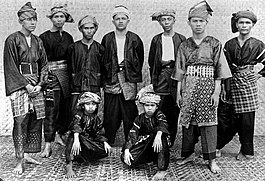


Minangkabau man with a tengkolok headgear.
| |
| Type | Traditional Headgear |
|---|---|
| Material | Songket |
| Place of origin | Maritime Southeast Asia[1] |
| Manufacturer | Malay people[2][3][4] Banjarese, Minangkabau,[5] Buginese, Makassar, Minahasa, Bajau, Kadazandusun, Gorontalo, Maguindanaon and Brunei Malay people |
Tengkolok, also known as Tanjak, Destar (Minangkabau: Deta; Kelantan-Pattani: Semutar)[6] is a traditional MalayorIndonesian[7] and male headgear. It is made from long songket cloth folded and tied in a particular style (solek). Nowadays, it is usually worn in ceremonial functions, such as royal ceremonies by royalties, and wedding ceremonies by grooms.[8]
The terms tengkolok, Tanjak, and setanjak are synonyms; the word "tengkolok" also refers to "headgear or headcover worn by women",[6] but the definition of women's headgear is rarely used today.[9]
However, some people[who?] say that tengkolok, tanjak, and destar are different in terms of cloth type or tying even though the purpose is the same, which the tengkolok is a headgear made from cloth of good quality and its tying has many layers and tapers to tip; destar has low tying and its tying layers are fewer than tengkolok; tanjak has tying much like tengkolok, the only difference is that its cloth is simple and thin.
Tengkolok is made in various forms, with different types and designs of cloth, depending on the social status of its dress.[10] The general term for different forms of tengkolokissolek. Each solek also has its different special name, for instance: the tengkolok worn by Yang di-Pertuan Agong during the coronation ceremony is known as Solek Dendam Tak Sudah (Persistent Vengeance Style).
Every Malay king has their particular solek. For example, the Sultan of Selangor wears a richly golden yellow Solek Balung Raja (Royal Crest Style) when attending a coronation ceremony or his birthday ceremony.
The traditional attire of the Brunei Malay population, locally known as destar, represents the significance of Malay rulers and nobility throughout history. In addition, it served as a representation of the social structure of the time, separating commoners from dignitaries until the head covering became the Malay custom of dressing.[11] Over two millennia have passed since the discovery of Brunei's destar types, which include Destar Taruna, Helang Benari, Singa Menerpa, Layar Bahtera, Nakhoda Sailar, and Hulubalang Diraja. The destar's production process, it was previously known that a high-quality dastar requires a week to complete, which has a more adaptable notion, is what makes it distinctive.[8]


|
| |||||||||
|---|---|---|---|---|---|---|---|---|---|
|
|
| ||||||||
| Helmets |
| ||||||||
| Other protective |
| ||||||||
| Hairwear and other items |
| ||||||||
| Eyewear |
| ||||||||
|
| |||||||||||||
|---|---|---|---|---|---|---|---|---|---|---|---|---|---|
| Africa |
| ||||||||||||
| Asia |
| ||||||||||||
| Europe |
| ||||||||||||
| South America |
| ||||||||||||
| North America |
| ||||||||||||
| Oceania |
| ||||||||||||
|
| |
|---|---|
Clothing identified with Indonesian culture and still worn today | |
| Textiles and weaving |
|
| Dyeing |
|
| Clothing |
|
| Headgear |
|
| Jewelry and ornaments |
|
| Armour |
|
| Footwear |
|
|
| |
|---|---|
| Textiles |
|
| Traditional |
|
| Headgear |
|
| Belts and sashes |
|
| Footwear |
|
| Accessories |
|